Effective Communication in Health and Social Care: An Essay
VerifiedAdded on 2021/05/30
|7
|1671
|22
Essay
AI Summary
This essay delves into the critical role of effective communication within health and social care settings. It examines the factors influencing communication, including cultural values, organizational policies, and relevant legislation like the Whistle Blowing Policy and Racial Discrimination Policy. The essay highlights how these elements impact the communication process, emphasizing the importance of respecting diverse viewpoints and adhering to ethical guidelines. Furthermore, it explores strategies for improving communication, such as providing feedback and offering training to professionals, especially concerning communication with individuals with disabilities. The essay underscores the need for continuous improvement to ensure optimal service delivery and meet the comprehensive needs of service users. By addressing these factors, the essay aims to promote better administrative procedures and ensure that all individuals are treated with respect and dignity.
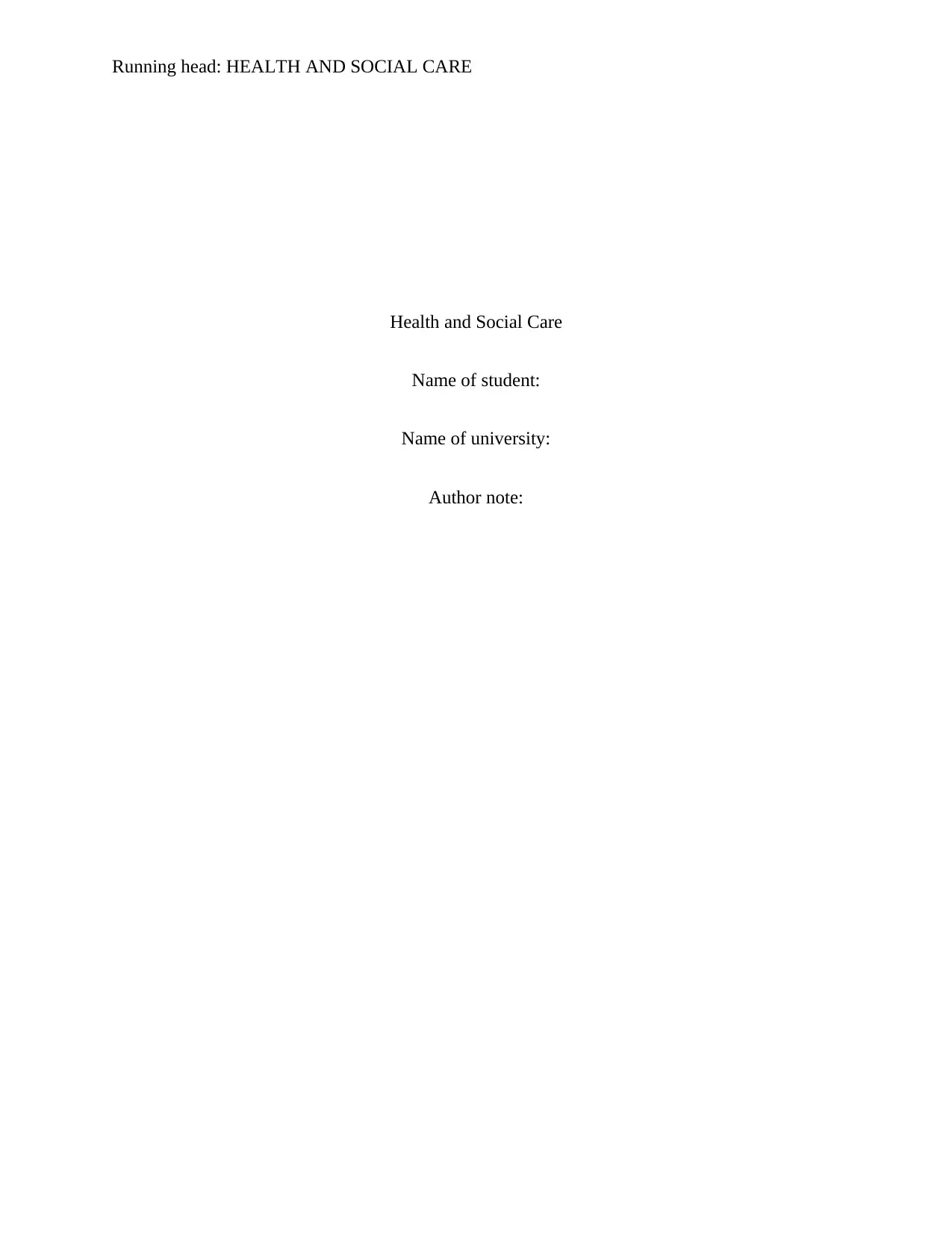
Running head: HEALTH AND SOCIAL CARE
Health and Social Care
Name of student:
Name of university:
Author note:
Health and Social Care
Name of student:
Name of university:
Author note:
Paraphrase This Document
Need a fresh take? Get an instant paraphrase of this document with our AI Paraphraser
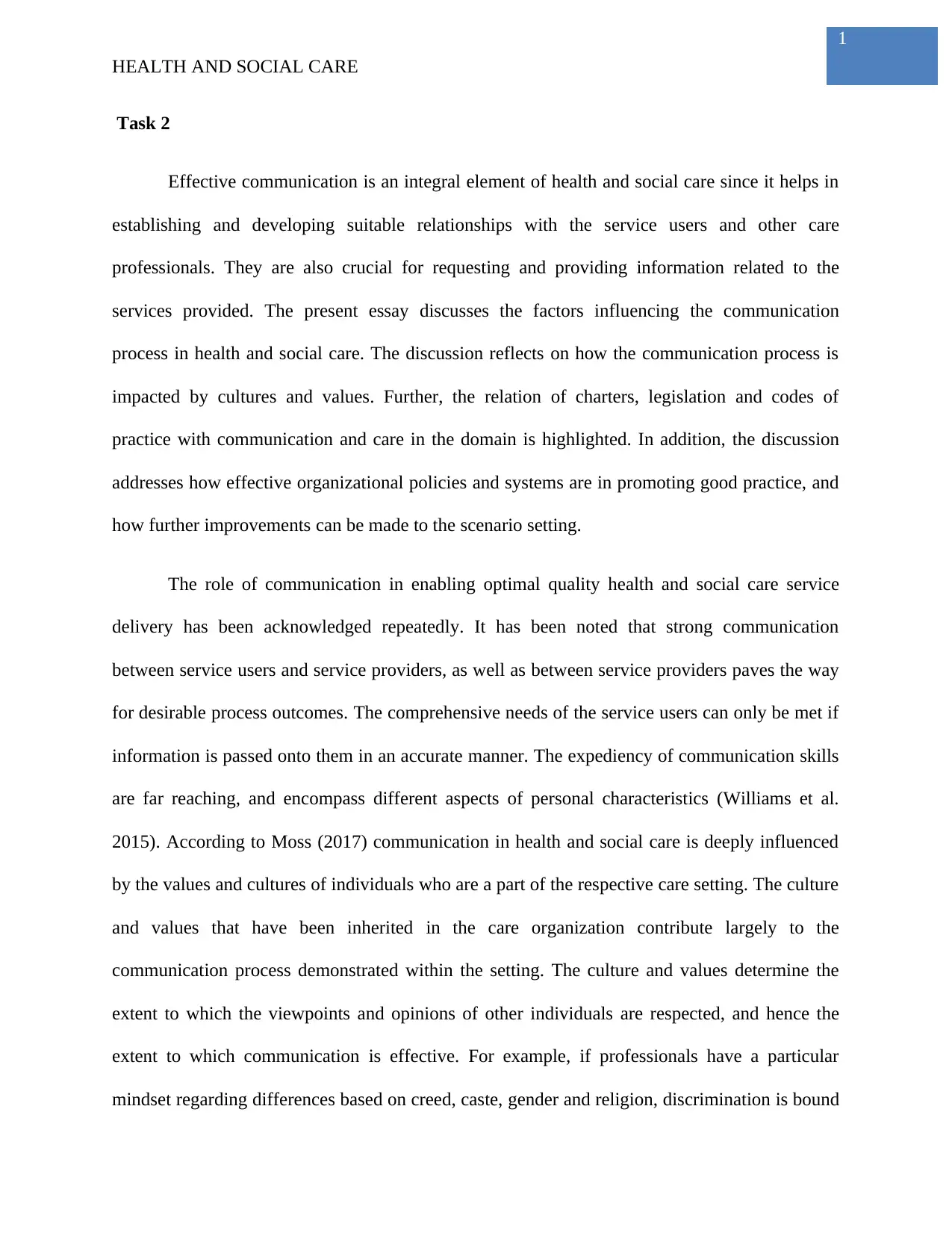
1
HEALTH AND SOCIAL CARE
Task 2
Effective communication is an integral element of health and social care since it helps in
establishing and developing suitable relationships with the service users and other care
professionals. They are also crucial for requesting and providing information related to the
services provided. The present essay discusses the factors influencing the communication
process in health and social care. The discussion reflects on how the communication process is
impacted by cultures and values. Further, the relation of charters, legislation and codes of
practice with communication and care in the domain is highlighted. In addition, the discussion
addresses how effective organizational policies and systems are in promoting good practice, and
how further improvements can be made to the scenario setting.
The role of communication in enabling optimal quality health and social care service
delivery has been acknowledged repeatedly. It has been noted that strong communication
between service users and service providers, as well as between service providers paves the way
for desirable process outcomes. The comprehensive needs of the service users can only be met if
information is passed onto them in an accurate manner. The expediency of communication skills
are far reaching, and encompass different aspects of personal characteristics (Williams et al.
2015). According to Moss (2017) communication in health and social care is deeply influenced
by the values and cultures of individuals who are a part of the respective care setting. The culture
and values that have been inherited in the care organization contribute largely to the
communication process demonstrated within the setting. The culture and values determine the
extent to which the viewpoints and opinions of other individuals are respected, and hence the
extent to which communication is effective. For example, if professionals have a particular
mindset regarding differences based on creed, caste, gender and religion, discrimination is bound
HEALTH AND SOCIAL CARE
Task 2
Effective communication is an integral element of health and social care since it helps in
establishing and developing suitable relationships with the service users and other care
professionals. They are also crucial for requesting and providing information related to the
services provided. The present essay discusses the factors influencing the communication
process in health and social care. The discussion reflects on how the communication process is
impacted by cultures and values. Further, the relation of charters, legislation and codes of
practice with communication and care in the domain is highlighted. In addition, the discussion
addresses how effective organizational policies and systems are in promoting good practice, and
how further improvements can be made to the scenario setting.
The role of communication in enabling optimal quality health and social care service
delivery has been acknowledged repeatedly. It has been noted that strong communication
between service users and service providers, as well as between service providers paves the way
for desirable process outcomes. The comprehensive needs of the service users can only be met if
information is passed onto them in an accurate manner. The expediency of communication skills
are far reaching, and encompass different aspects of personal characteristics (Williams et al.
2015). According to Moss (2017) communication in health and social care is deeply influenced
by the values and cultures of individuals who are a part of the respective care setting. The culture
and values that have been inherited in the care organization contribute largely to the
communication process demonstrated within the setting. The culture and values determine the
extent to which the viewpoints and opinions of other individuals are respected, and hence the
extent to which communication is effective. For example, if professionals have a particular
mindset regarding differences based on creed, caste, gender and religion, discrimination is bound
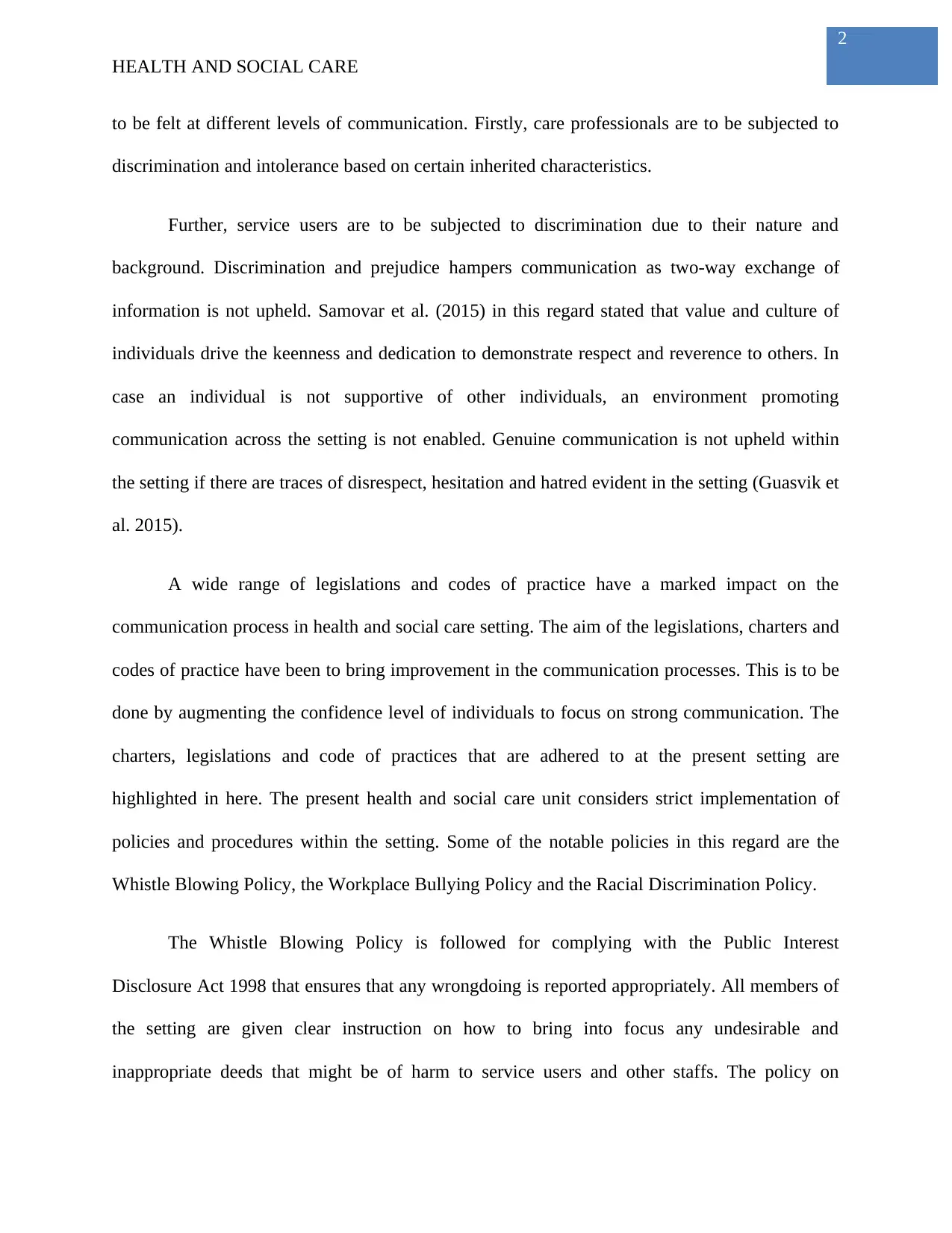
2
HEALTH AND SOCIAL CARE
to be felt at different levels of communication. Firstly, care professionals are to be subjected to
discrimination and intolerance based on certain inherited characteristics.
Further, service users are to be subjected to discrimination due to their nature and
background. Discrimination and prejudice hampers communication as two-way exchange of
information is not upheld. Samovar et al. (2015) in this regard stated that value and culture of
individuals drive the keenness and dedication to demonstrate respect and reverence to others. In
case an individual is not supportive of other individuals, an environment promoting
communication across the setting is not enabled. Genuine communication is not upheld within
the setting if there are traces of disrespect, hesitation and hatred evident in the setting (Guasvik et
al. 2015).
A wide range of legislations and codes of practice have a marked impact on the
communication process in health and social care setting. The aim of the legislations, charters and
codes of practice have been to bring improvement in the communication processes. This is to be
done by augmenting the confidence level of individuals to focus on strong communication. The
charters, legislations and code of practices that are adhered to at the present setting are
highlighted in here. The present health and social care unit considers strict implementation of
policies and procedures within the setting. Some of the notable policies in this regard are the
Whistle Blowing Policy, the Workplace Bullying Policy and the Racial Discrimination Policy.
The Whistle Blowing Policy is followed for complying with the Public Interest
Disclosure Act 1998 that ensures that any wrongdoing is reported appropriately. All members of
the setting are given clear instruction on how to bring into focus any undesirable and
inappropriate deeds that might be of harm to service users and other staffs. The policy on
HEALTH AND SOCIAL CARE
to be felt at different levels of communication. Firstly, care professionals are to be subjected to
discrimination and intolerance based on certain inherited characteristics.
Further, service users are to be subjected to discrimination due to their nature and
background. Discrimination and prejudice hampers communication as two-way exchange of
information is not upheld. Samovar et al. (2015) in this regard stated that value and culture of
individuals drive the keenness and dedication to demonstrate respect and reverence to others. In
case an individual is not supportive of other individuals, an environment promoting
communication across the setting is not enabled. Genuine communication is not upheld within
the setting if there are traces of disrespect, hesitation and hatred evident in the setting (Guasvik et
al. 2015).
A wide range of legislations and codes of practice have a marked impact on the
communication process in health and social care setting. The aim of the legislations, charters and
codes of practice have been to bring improvement in the communication processes. This is to be
done by augmenting the confidence level of individuals to focus on strong communication. The
charters, legislations and code of practices that are adhered to at the present setting are
highlighted in here. The present health and social care unit considers strict implementation of
policies and procedures within the setting. Some of the notable policies in this regard are the
Whistle Blowing Policy, the Workplace Bullying Policy and the Racial Discrimination Policy.
The Whistle Blowing Policy is followed for complying with the Public Interest
Disclosure Act 1998 that ensures that any wrongdoing is reported appropriately. All members of
the setting are given clear instruction on how to bring into focus any undesirable and
inappropriate deeds that might be of harm to service users and other staffs. The policy on
⊘ This is a preview!⊘
Do you want full access?
Subscribe today to unlock all pages.

Trusted by 1+ million students worldwide
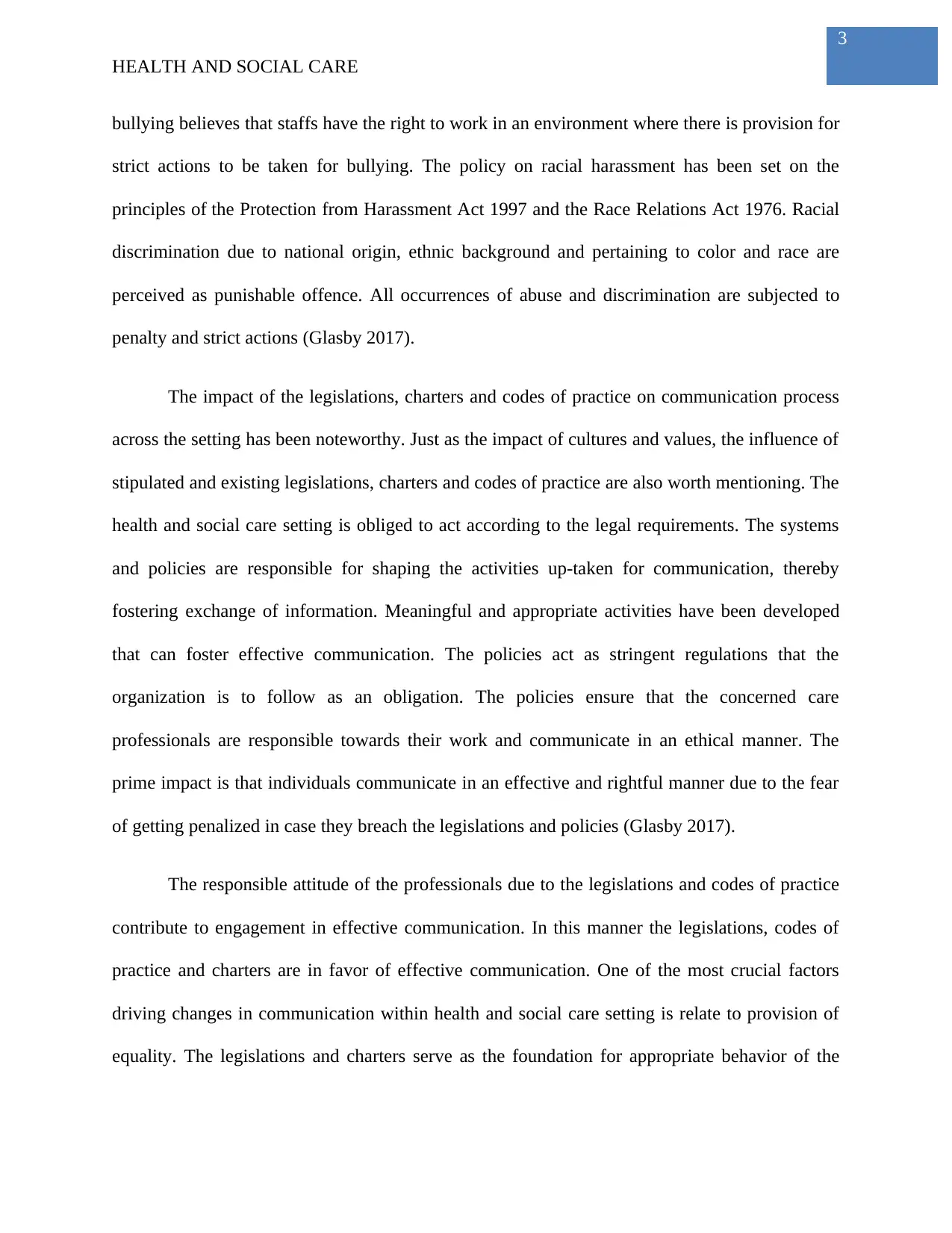
3
HEALTH AND SOCIAL CARE
bullying believes that staffs have the right to work in an environment where there is provision for
strict actions to be taken for bullying. The policy on racial harassment has been set on the
principles of the Protection from Harassment Act 1997 and the Race Relations Act 1976. Racial
discrimination due to national origin, ethnic background and pertaining to color and race are
perceived as punishable offence. All occurrences of abuse and discrimination are subjected to
penalty and strict actions (Glasby 2017).
The impact of the legislations, charters and codes of practice on communication process
across the setting has been noteworthy. Just as the impact of cultures and values, the influence of
stipulated and existing legislations, charters and codes of practice are also worth mentioning. The
health and social care setting is obliged to act according to the legal requirements. The systems
and policies are responsible for shaping the activities up-taken for communication, thereby
fostering exchange of information. Meaningful and appropriate activities have been developed
that can foster effective communication. The policies act as stringent regulations that the
organization is to follow as an obligation. The policies ensure that the concerned care
professionals are responsible towards their work and communicate in an ethical manner. The
prime impact is that individuals communicate in an effective and rightful manner due to the fear
of getting penalized in case they breach the legislations and policies (Glasby 2017).
The responsible attitude of the professionals due to the legislations and codes of practice
contribute to engagement in effective communication. In this manner the legislations, codes of
practice and charters are in favor of effective communication. One of the most crucial factors
driving changes in communication within health and social care setting is relate to provision of
equality. The legislations and charters serve as the foundation for appropriate behavior of the
HEALTH AND SOCIAL CARE
bullying believes that staffs have the right to work in an environment where there is provision for
strict actions to be taken for bullying. The policy on racial harassment has been set on the
principles of the Protection from Harassment Act 1997 and the Race Relations Act 1976. Racial
discrimination due to national origin, ethnic background and pertaining to color and race are
perceived as punishable offence. All occurrences of abuse and discrimination are subjected to
penalty and strict actions (Glasby 2017).
The impact of the legislations, charters and codes of practice on communication process
across the setting has been noteworthy. Just as the impact of cultures and values, the influence of
stipulated and existing legislations, charters and codes of practice are also worth mentioning. The
health and social care setting is obliged to act according to the legal requirements. The systems
and policies are responsible for shaping the activities up-taken for communication, thereby
fostering exchange of information. Meaningful and appropriate activities have been developed
that can foster effective communication. The policies act as stringent regulations that the
organization is to follow as an obligation. The policies ensure that the concerned care
professionals are responsible towards their work and communicate in an ethical manner. The
prime impact is that individuals communicate in an effective and rightful manner due to the fear
of getting penalized in case they breach the legislations and policies (Glasby 2017).
The responsible attitude of the professionals due to the legislations and codes of practice
contribute to engagement in effective communication. In this manner the legislations, codes of
practice and charters are in favor of effective communication. One of the most crucial factors
driving changes in communication within health and social care setting is relate to provision of
equality. The legislations and charters serve as the foundation for appropriate behavior of the
Paraphrase This Document
Need a fresh take? Get an instant paraphrase of this document with our AI Paraphraser
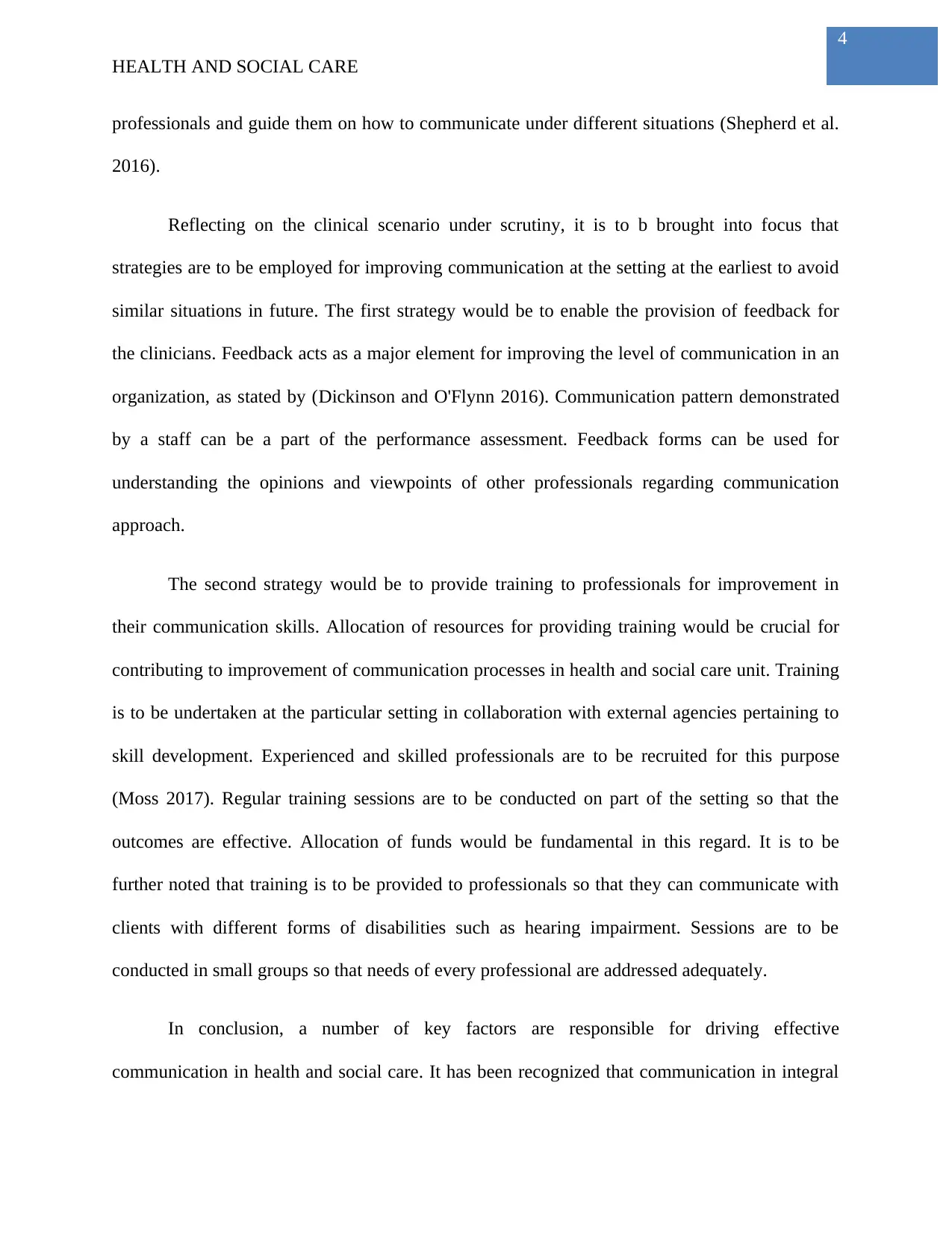
4
HEALTH AND SOCIAL CARE
professionals and guide them on how to communicate under different situations (Shepherd et al.
2016).
Reflecting on the clinical scenario under scrutiny, it is to b brought into focus that
strategies are to be employed for improving communication at the setting at the earliest to avoid
similar situations in future. The first strategy would be to enable the provision of feedback for
the clinicians. Feedback acts as a major element for improving the level of communication in an
organization, as stated by (Dickinson and O'Flynn 2016). Communication pattern demonstrated
by a staff can be a part of the performance assessment. Feedback forms can be used for
understanding the opinions and viewpoints of other professionals regarding communication
approach.
The second strategy would be to provide training to professionals for improvement in
their communication skills. Allocation of resources for providing training would be crucial for
contributing to improvement of communication processes in health and social care unit. Training
is to be undertaken at the particular setting in collaboration with external agencies pertaining to
skill development. Experienced and skilled professionals are to be recruited for this purpose
(Moss 2017). Regular training sessions are to be conducted on part of the setting so that the
outcomes are effective. Allocation of funds would be fundamental in this regard. It is to be
further noted that training is to be provided to professionals so that they can communicate with
clients with different forms of disabilities such as hearing impairment. Sessions are to be
conducted in small groups so that needs of every professional are addressed adequately.
In conclusion, a number of key factors are responsible for driving effective
communication in health and social care. It has been recognized that communication in integral
HEALTH AND SOCIAL CARE
professionals and guide them on how to communicate under different situations (Shepherd et al.
2016).
Reflecting on the clinical scenario under scrutiny, it is to b brought into focus that
strategies are to be employed for improving communication at the setting at the earliest to avoid
similar situations in future. The first strategy would be to enable the provision of feedback for
the clinicians. Feedback acts as a major element for improving the level of communication in an
organization, as stated by (Dickinson and O'Flynn 2016). Communication pattern demonstrated
by a staff can be a part of the performance assessment. Feedback forms can be used for
understanding the opinions and viewpoints of other professionals regarding communication
approach.
The second strategy would be to provide training to professionals for improvement in
their communication skills. Allocation of resources for providing training would be crucial for
contributing to improvement of communication processes in health and social care unit. Training
is to be undertaken at the particular setting in collaboration with external agencies pertaining to
skill development. Experienced and skilled professionals are to be recruited for this purpose
(Moss 2017). Regular training sessions are to be conducted on part of the setting so that the
outcomes are effective. Allocation of funds would be fundamental in this regard. It is to be
further noted that training is to be provided to professionals so that they can communicate with
clients with different forms of disabilities such as hearing impairment. Sessions are to be
conducted in small groups so that needs of every professional are addressed adequately.
In conclusion, a number of key factors are responsible for driving effective
communication in health and social care. It has been recognized that communication in integral
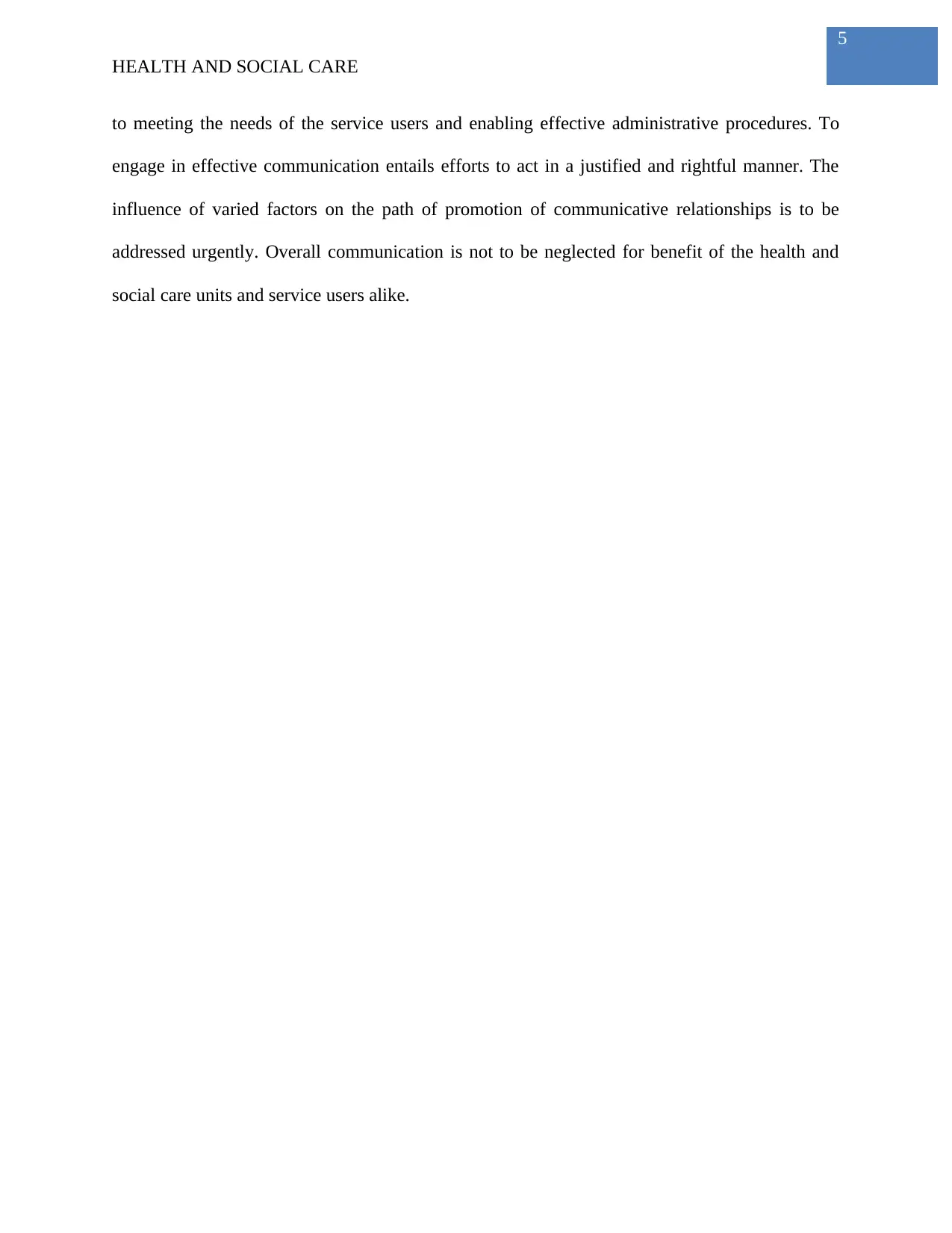
5
HEALTH AND SOCIAL CARE
to meeting the needs of the service users and enabling effective administrative procedures. To
engage in effective communication entails efforts to act in a justified and rightful manner. The
influence of varied factors on the path of promotion of communicative relationships is to be
addressed urgently. Overall communication is not to be neglected for benefit of the health and
social care units and service users alike.
HEALTH AND SOCIAL CARE
to meeting the needs of the service users and enabling effective administrative procedures. To
engage in effective communication entails efforts to act in a justified and rightful manner. The
influence of varied factors on the path of promotion of communicative relationships is to be
addressed urgently. Overall communication is not to be neglected for benefit of the health and
social care units and service users alike.
⊘ This is a preview!⊘
Do you want full access?
Subscribe today to unlock all pages.

Trusted by 1+ million students worldwide
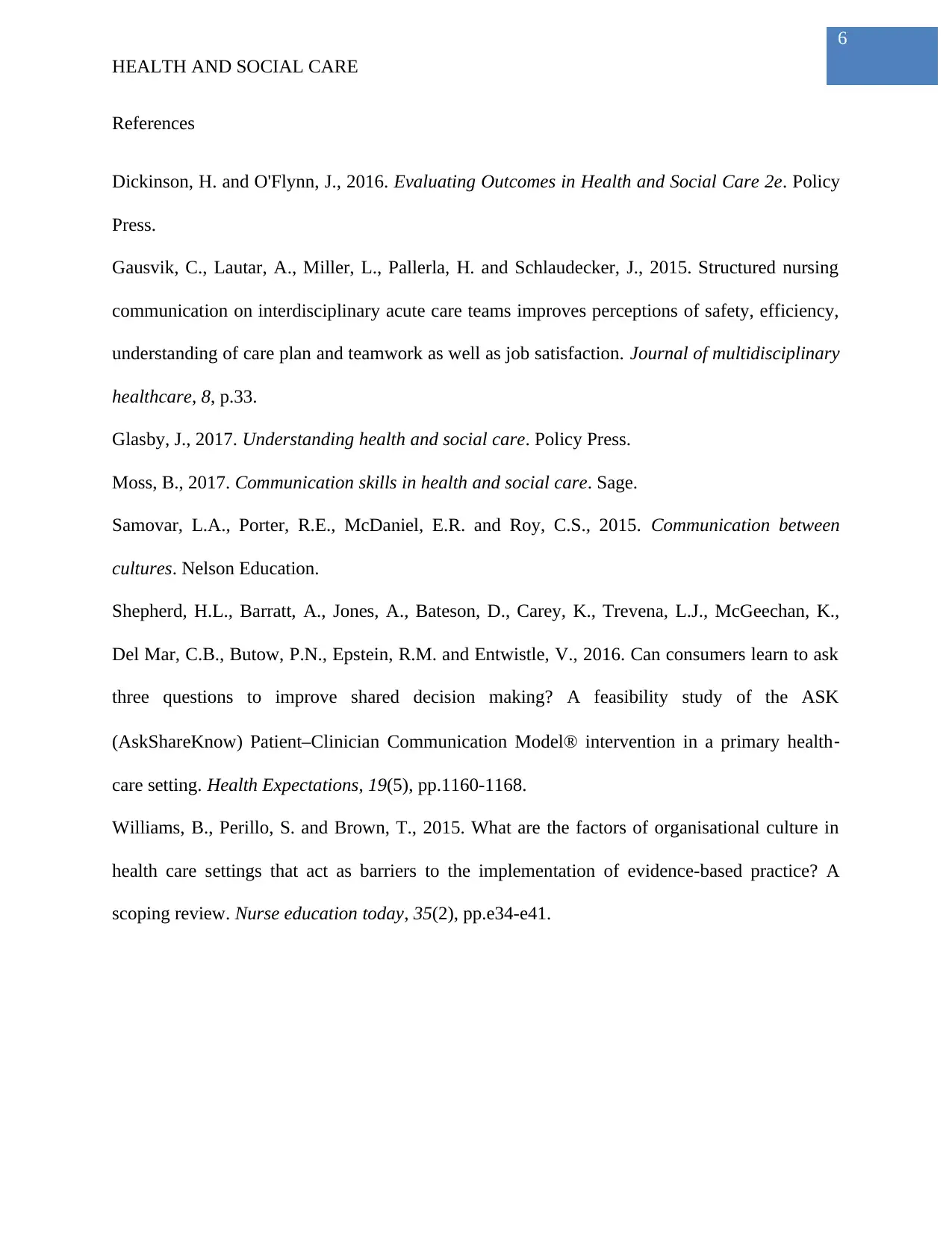
6
HEALTH AND SOCIAL CARE
References
Dickinson, H. and O'Flynn, J., 2016. Evaluating Outcomes in Health and Social Care 2e. Policy
Press.
Gausvik, C., Lautar, A., Miller, L., Pallerla, H. and Schlaudecker, J., 2015. Structured nursing
communication on interdisciplinary acute care teams improves perceptions of safety, efficiency,
understanding of care plan and teamwork as well as job satisfaction. Journal of multidisciplinary
healthcare, 8, p.33.
Glasby, J., 2017. Understanding health and social care. Policy Press.
Moss, B., 2017. Communication skills in health and social care. Sage.
Samovar, L.A., Porter, R.E., McDaniel, E.R. and Roy, C.S., 2015. Communication between
cultures. Nelson Education.
Shepherd, H.L., Barratt, A., Jones, A., Bateson, D., Carey, K., Trevena, L.J., McGeechan, K.,
Del Mar, C.B., Butow, P.N., Epstein, R.M. and Entwistle, V., 2016. Can consumers learn to ask
three questions to improve shared decision making? A feasibility study of the ASK
(AskShareKnow) Patient–Clinician Communication Model® intervention in a primary health‐
care setting. Health Expectations, 19(5), pp.1160-1168.
Williams, B., Perillo, S. and Brown, T., 2015. What are the factors of organisational culture in
health care settings that act as barriers to the implementation of evidence-based practice? A
scoping review. Nurse education today, 35(2), pp.e34-e41.
HEALTH AND SOCIAL CARE
References
Dickinson, H. and O'Flynn, J., 2016. Evaluating Outcomes in Health and Social Care 2e. Policy
Press.
Gausvik, C., Lautar, A., Miller, L., Pallerla, H. and Schlaudecker, J., 2015. Structured nursing
communication on interdisciplinary acute care teams improves perceptions of safety, efficiency,
understanding of care plan and teamwork as well as job satisfaction. Journal of multidisciplinary
healthcare, 8, p.33.
Glasby, J., 2017. Understanding health and social care. Policy Press.
Moss, B., 2017. Communication skills in health and social care. Sage.
Samovar, L.A., Porter, R.E., McDaniel, E.R. and Roy, C.S., 2015. Communication between
cultures. Nelson Education.
Shepherd, H.L., Barratt, A., Jones, A., Bateson, D., Carey, K., Trevena, L.J., McGeechan, K.,
Del Mar, C.B., Butow, P.N., Epstein, R.M. and Entwistle, V., 2016. Can consumers learn to ask
three questions to improve shared decision making? A feasibility study of the ASK
(AskShareKnow) Patient–Clinician Communication Model® intervention in a primary health‐
care setting. Health Expectations, 19(5), pp.1160-1168.
Williams, B., Perillo, S. and Brown, T., 2015. What are the factors of organisational culture in
health care settings that act as barriers to the implementation of evidence-based practice? A
scoping review. Nurse education today, 35(2), pp.e34-e41.
1 out of 7
Related Documents
Your All-in-One AI-Powered Toolkit for Academic Success.
+13062052269
info@desklib.com
Available 24*7 on WhatsApp / Email
![[object Object]](/_next/static/media/star-bottom.7253800d.svg)
Unlock your academic potential
Copyright © 2020–2025 A2Z Services. All Rights Reserved. Developed and managed by ZUCOL.





